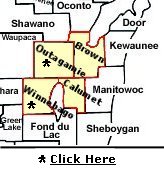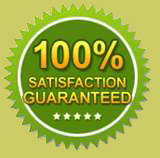|
Serving
NE Wisconsin
Since 1985
Green
Bay
920-465-4972
Appleton
Fox Valley
920-967-0121
Oshkosh
920-233-2900
|
 |

How-To
Select
The
Best!
Click
Here

Direct
Link
U.S.
Environmental
Protection
Agency
|
Environment
Safe, Eco-Friendly
First,
Approach
To Pest
Control Materials & Services ...
According
to the Environmental Protection Agency (EPA), Integrated
Pest
Management (IPM) is
an effective and environmentally sensitive (eco-friendly)
approach to pest management (pest control services) that relies on a
combination of common-sense practices." The EPA
gives Integrated
Pest Management (aka: Integrated Pest Control) its highest
recommendation!
IPM
programs use current, comprehensive information on the life
cycles of
pests and their interaction with the environment. This
information, in
combination with available pest control methods, is used to manage
pest
damage by the most economical means, and with the least possible hazard
to people, property, and the environment.
People
appreciate comfortable environments in which to live and work.
Environments that are comfortable to people may also provide food,
water and harborage (homes & buildings) to pests. By using
integrated strategies
for pest management, we can reduce numbers of pests as well as maintain
a healthy environment.
IPM
is a process for balancing the risks between pests and pesticides to
achieve long term pest suppression. IPM uses a wide variety of
management practices. Control strategies in an IPM program extend
beyond the application of pesticides to include
structural and
procedural modifications that reduce the food, water, harborage, and
access used by pests.
Why
Use Integrated Pest Management?
IPM
programs are designed to reduce health hazards to the people that
inhabit the building or structures.
IPM
programs accomplish this by using approaches such as sanitation,
baiting for pests, trapping
pests,
and monitoring for pests and using
the least hazardous/least
toxic
pesticides when the need is
demonstrated.
By
having an IPM program in place, you are taking special protective
measures to reduce pesticide exposure to non-pest organisms and the
environment.
How
Does Integrated Pest Management Work?
IPM
is not a single pest control method but, rather, a series of pest
management evaluations, decisions and controls. In practicing IPM,
people who are aware of the potential for pest infestation follow a
four-tiered approach. The four steps include:
-
Set
Action
Thresholds
Before taking any pest control action, IPM first sets an action
threshold, a point at which pest populations or environmental
conditions indicate that pest control action must be taken. Sighting a
single pest does not always mean control is needed. The level at which
pests will either become an economic or health threat is critical to
guide future pest control decisions.
-
Monitor
and
Identify Pests
Not all insects, weeds, and other living organisms require control.
Many organisms are innocuous, and some are even beneficial. IPM
programs work to monitor for pests and identify them accurately, so
that appropriate control decisions can be made in conjunction with
action thresholds. This monitoring and identification removes the
possibility that pesticides will be used when they are not really
needed or that the wrong kind of pesticide will be used.
-
Prevention
As a first line of pest control, IPM programs work to manage the crop,
lawn, or indoor space to prevent pests from becoming a threat. In an
agricultural crop, this may mean using cultural methods, such as
rotating between different crops, selecting pest-resistant varieties,
and planting pest-free rootstock. In a home it can be as simple as
making sure clutter is reduced, window screens are keeping pests
outside, and food is not available for pests. These control methods can
be very effective and cost-efficient and
present
little to no risk to
people or the environment.
- Control
Once monitoring, identification, and action thresholds indicate that
pest control is required, and preventive methods are no longer
effective or available, IPM programs then evaluate the proper control
method both for effectiveness and risk. Effective, less
risky
pest
controls are chosen first, including highly targeted
chemicals, such as
pheromones to disrupt pest mating, or mechanical control, such as
trapping or weeding. If further monitoring, identifications and action
thresholds indicate that less risky controls are not working, then
additional pest control methods would be employed, such as targeted
bait applications or the spraying of pesticides. Broadcast spraying of
non-specific pesticides is a last resort.
How
Can You Help with Integrated Pest Management in Your Home or Workplace?
Upon
calling MB Integrated Pest Control, please leave your home/building in
its present condition whenever and wherever possible. Our technician
will need to inspect and identify
possible pest
entry/habitat areas to
achieve quick and thorough extermination. Our technician will openly
speak to you about his/her findings, point out specific problem areas,
and coach you on cost-saving and preventive measures you may be able to
apply, yourself.
AFTER
our pest control technician's initial inspection, we suggest that you
begin with exclusion and then move on to the other tasks (methods of
IPM) listed below. Each plays an intimate role in aiding in the elimination
and prevention
of pests.
-
Exclusion: Blocking entry
points for pests
such as caulking around windows, making
sure door sweeps are tightly in place and patching holes.
-
Yard/Grounds
Maintenance:
Pest presences usually come from
outdoor populations.
Keep your grass mowed and trees and shrubs from becoming overgrown, you
can help keep pest populations under control.
Trees, shrubs, and plants should not be touching your home. It gives
pests a bridge to crawl up and find places to come in. Pine, straw and
mulch should also be kept away from the exterior of your home. It
serves as a place for many pests (such as cockroaches) to live and
breed.
-
Sanitation:
Keeping a space clean and tidy. Food that is left out in the open is
attractive to pests and can be the reason they come inside. Piles of
clutter indoors can provide hidden shelter for pests to live in once
they come inside.
-
Traps:
Provided
by MB Integrated Pest Control, with service; amount
appropriate
to situation. There are a variety of traps for mammals (mouse traps,
live traps) and for insects (pheromone traps, sticky traps). Traps can
be used to determine what kind of problem you have, to monitor for the
pest and can also be a way to help reduce populations.
If you prefer live-trapping for release, make sure to have practiced
exclusion by blocking the pests point of entry. This is especially good
for larger mammals that may have somehow found their way into your home.
-
Baits:
Provided by MB Integrated Pest Control, with
service; number
appropriate to situation. Considered a safe chemical management option.
Qualities of a good bait include: an odor that smells attractive to the
pest, a pesticide that is effective against the pest, a holder or “bait
station” that will prevent children or pets from being able to access
it, and a design that is suited to the pests behavior.
These
are just some of the tactics that can be used, but the main thing to
keep in mind is that pests need food, water, and shelter.
If you
eliminate their food sources and shelter, pests will have to go
elsewhere to fulfill their life requirements.
MB
Integrated Pest Control
has
proven expertise in pest behaviors,
likely habitats, and their reproduction/life cycles.
Professional
knowledge of these critical points, and more, provides safe and
effective elimination management.
MB
Integrated Pest Control will conduct a thorough search of
your
home's interior AND exterior to find problem areas, targeting actual
pest locations rather than wasting time and money guessing where they
may be. This practice ensures safer measures and greater success, by
restricting supplies and materials to areas only where needed, not
beyond.
|